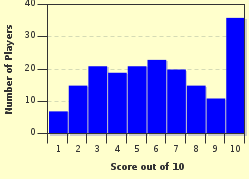Quiz Answer Key and Fun Facts
1. For what was the stiff format punched card first used?
2. The modern punched card (now pretty much obsolete), similar to what became the mainstay of computing input, was developed in 1890. What was it developed to support?
3. What was the name of the company whose focus was punched card driven data that Herman Hollerith formed in 1896 that through a series of mergers emerged as International Business Machines (IBM)?
4. All computers use/used the same size and format of punched cards.
5. The punched card was so prevalent by the middle of the 20th century that we still quote a warning which appeared on many of the distributed cards came with the following warning: "Do not fold, _______ or mutilate"
6. It was possible to punch out all the positions on an IBM 80 column card. Putting 12 rows of 80 columns of rectangular holes in a card 7 3/8" x 3 1/4" left a very flimsy "novelty" card that was not capable of passing through a card reader. What were these cards commonly called?
7. The holes in cards might be round (as the ones in the 1890 Census cards were), oval, or rectangular. What were the bits of paper that were punched out called?
8. The IBM card format with 80 columns and 12 rows was used with IBM mainframe computers since mid-1960s to encode data in which format?
9. Although not technically punched, there were punched cards that allowed data entry by using a special electrographic pencil to shade designated ovals on the card. Special card reader sensed these markings and were programmed to punch out additional holes in the cards based on the shadings which could then be process by traditional unit record equipment. What were these cards called?
10. Some events during the 2000 U.S. Presidential Election brought negative publicity to the use of punched cards as a voting medium. This was associated with the use of Votomatic type machines in which state?
Source: Author
key_man
This quiz was reviewed by FunTrivia editor
crisw before going online.
Any errors found in FunTrivia content are routinely corrected through our feedback system.

